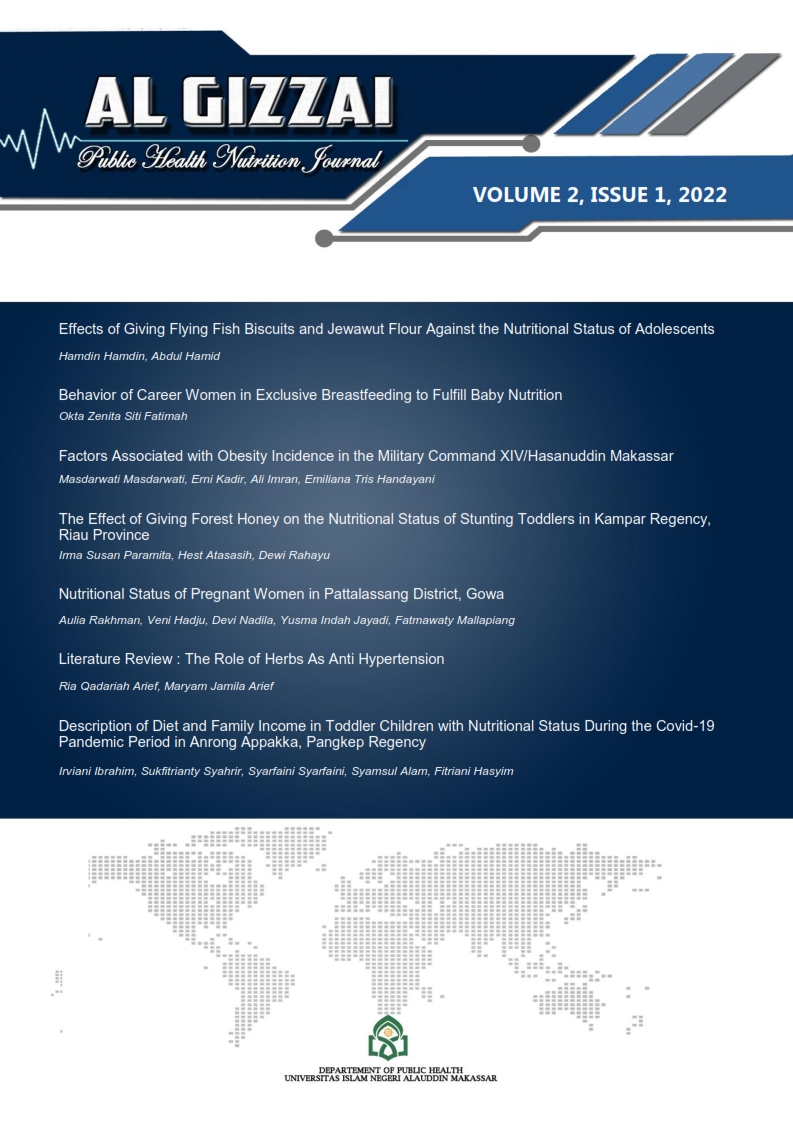Nutritional Status of Pregnant Women in Pattalassang District, Gowa
Abstract
The purpose of the study was to see the relationship between household characteristics and the nutritional status of pregnant women in Pattallassang District, Gowa Regency. Methods: This study used an analytical survey method. The study population consisted of all pregnant women found in the working area of the Pattalassang Community Health Center. The cluster sampling technique was applied to determine the part of the district/city. Data collection was carried out by trained personnel including 1x24 hour withdrawal, weight, height, and upper arm circumference (UAC). The data were analyzed using the SPSS 20 program. The determination of the risk of CED was based on LiLA <23.5 cm. Results: In general, pregnant women in this study were on average 26-35 years old (52%). Among them 36% only graduated from elementary school, the average gestational age of a mother is in the second trimester, and all of them are Muslim. The prevalence of CED risk is 18%. The relationship between education and nutritional status of pregnant women with a significance value of p = 0.089 (p> 0.05). The relationship between family income and nutritional status of pregnant women has a significance value of p = 0.664 (p> 0.05). Conclusion: there is no significant relationship between income and education with nutritional status.
References
Ahmed, K. Y., Rwabilimbo, A. G., Abrha, S., Page, A., Arora, A., Tadese, F., Beyene, T. Y., Seiko, A., Endris, A. A., Agho, K. E., Ogbo, F. A., & collaboration (GloMACH), on behalf of the G. M. and C. H. R. (2020). Factors associated with underweight, overweight, and obesity in reproductive age Tanzanian women. PLOS ONE, 15(8), e0237720. https://doi.org/10.1371/journal.pone.0237720
Ali, H. (2009). Pengantar keperawatan keluarga. EGC.
Andriani, Z. (2015). Gambaran status gizi ibu hamil berdasarkan ukuran lingkar lengan atas (LILA) di Kelurahan Sukamaju Kota Depok. https://repository.uinjkt.ac.id/dspace/handle/123456789/37814
Anggiani, F. N. (2016). Faktor-Faktor Yang Berhubungan Dengan Kejadian Kekurangan Energi Kronik (KEK) Pada Ibu Hamil Di Puskesmas Halmahera Semarang. Skripsi,Fakultas Kesehatan. https://doi.org/10/bab2_18279.pdf
Arisman, M. (2009). Gizi dalam Daur Kehidupan: Vol. Edisi ke-2. EGC.
Ausa, E. S., Jafar, N., & Indriasari, R. (2013). Hubungan Pola Makan Dan Status Sosial Ekonomi Dengan Kejadian KEK Pada Ibu Hamil Di Kabupaten Gowa Tahun 2013.
Awalia, A. (2015). Gambar Tingkat Pengetahuan, Penghasilan Keluarga Pascapersalinan dan Status Gizi Bayi di Wilayah Sudiang Raya, Kabupaten Biringkanaya, Kota Makassar. Departemen Nutrisi Politeknik Kesehatan Makassar.
Balitbang Kemenkes, R. I. (2013). Riset kesehatan dasar; RISKESDAS. Jakarta: Balitbang Kemenkes RI, 2013, 110–9.
Barker, D. J., Gelow, J., Thornburg, K., Osmond, C., Kajantie, E., & Eriksson, J. G. (2010). The early origins of chronic heart failure: Impaired placental growth and initiation of insulin resistance in childhood. European Journal of Heart Failure, 12(8), 819–825.
Depkes, R. I. (1995). Buku Pedoman Kegiatan Kader di Posyandu. Jakarta.
Engka, N. (2013). Gambaran Umum Status Gizi dan Persepsi Ketersediaan Makanan pada Anak-anak Sekolah Keluarga Miskin di Desa Paccerakkang, Kecamatan Biringkanaya, Kota Makassar. Departemen Nutrisi Politeknik Kesehatan Makassar.
Fall, C. H., Yajnik, C. S., Rao, S., Davies, A. A., Brown, N., & Farrant, H. J. (2003). Micronutrients and fetal growth. The Journal of Nutrition, 133(5), 1747S–1756S.
Handayani, S., & Budianingrum, S. (2015). Analisis Faktor Yang Mempengaruhi Kekurangan Energi Kronis Pada Ibu Hamil Di Wilayah Puskesmas Wedi Klaten. INVOLUSI Jurnal Ilmu Kebidanan, 1(1), Article 1. http://jurnal.stikesmukla.ac.id/index.php/involusi/article/view/17
Indriany, I., Helmyati, S., & Paramashanti, B. A. (2016). Tingkat sosial ekonomi tidak berhubungan dengan kurang energi kronis (KEK) pada ibu hamil. Jurnal Gizi Dan Dietetik Indonesia (Indonesian Journal of Nutrition and Dietetics), 2(3), 116–125.
Kemenkes R. I. (2018). Buku Saku Pemantauan Status Gizi Tahun 2017. Direktorat Gizi Masyarakat Dirjen Binkesmas.
Najoan, J. A., & Manampiring, A. E. (2010, December). Hubungan Tingkat Sosial Ekonomi Dengan Kurang Energy Kronik Pada Ibu Hamil Di Kelurahan Kombos Barat Kecamatan Singkil Kota Manado [Other]. Laporan Penelitian IPTEK dan SENI (Lembaga Penelitian). http://repo.unsrat.ac.id/253/
Nursanti. (2005). Faktor-Faktor yang Berhubungan dengan Asupan Nutrisi Ibu Hamil di Puskesmas Kabupaten Cilincing, Jakarta Utara. Jurnal Kedokteran Dan Kesehatan.
PanaI, H. (2013). Hubungan Ekonomi Keluarga Dengan Status Gizi Ibu Hamil Di Puskesmas Wongkaditi Kota Gorontalo. Sainstek, 7(02).
Pomalingo, A. Y., Setiawan, D. I., & Misnati, M. (2018). Karakteristik Ibu Hamil Kurang Energi Kronis (KEK) Di Kecamatan Tilango Kabupaten Gorontalo. Journal Health And Nutritions, 4(1), 36–44.
Rocco, P. L., Orbitello, B., Perini, L., Pera, V., Ciano, R. P., & Balestrieri, M. (2005). Effects of pregnancy on eating attitudes and disorders: A prospective study. Journal of Psychosomatic Research, 59(3), 175–179.
Yuliastuti, E. (2014). Faktor-faktor yang berhubungan dengan kekurangan energi kronis pada ibu hamil di Wilayah Kerja Puskesmas Sungai Bilu Banjarmasin. An-Nadaa: Jurnal Kesehatan Masyarakat, 1(2), 72–76.
Copyright (c) 2022 Aulia Rakhman

This work is licensed under a Creative Commons Attribution-NonCommercial-ShareAlike 4.0 International License.
Authors retain copyright and grant the journal right of first publication with the work simultaneously licensed under a Creative Commons Attribution-NonCommercial-ShareAlike 4.0 International License that allows others to share the work with an acknowledgment of the work's authorship and initial publication in this journal.
Authors are able to enter into separate, additional contractual arrangements for the non-exclusive distribution of the journal's published version of the work (e.g., post it to an institutional repository or publish it in a book), with an acknowledgement of its initial publication in this journal.
Authors are permitted to publish their work online in third parties as it can lead to wider dissemination of the work.










